ISSN 2768-4261 (Online)

A Journal of Tibetan Literature, Arts and Humanities
Curatorial Reflections on ‘Transforming Minds: Kyabje Gelek Rimpoche and Friends, Photographs by Allen Ginsberg 1989-1997’
Ben Paljor Chatag
“Creating a work of art is an act of generosity, a gift whose purpose is to relieve suffering.”— Gelek Rimpoche
Gelek Rimpoche (1938-2017) was my grandfather. He was one of the last Tibetan Buddhist lamas to be educated at the Drepung Monastery in Tibet prior to the Chinese occupation, later becoming a renowned Buddhist scholar and teacher. Forced to flee Tibet in 1959, he began teaching westerners in India in 1975 at the direction of the senior and junior tutors to His Holiness the XIV Dalai Lama. By the late 1980s, Rimpoche had moved to Michigan and established Jewel Heart there, having already opened centers across Europe and Asia. Rimpoche is still remembered for his thorough knowledge of English, his understanding of contemporary culture, and his efficacy in imparting authentic Tibetan Buddhist teachings to his students all around the world.
Rimpoche brought me to America when I was 15. I was fortunate to know and spend many years with him, taking teachings from him in Buddhism and often taking many photographs of him teaching others. I have always felt an affinity to photography and feel they have this intrinsic quality to capture and preserve memories. In the early years, before I knew anything about Allen Ginsberg (1926-1997), I observed a few black and white photos of Rimpoche on Jewel Heart holiday cards. Curious to know who took these photos, it was communicated to me that Allen was the photographer. These experiences perhaps laid the seed for my future involvement in the archival project, which took the form of a photo exhibition.
Between 2018 and 2021, it was my honor to collaborate on developing and co-curating the exhibition Transforming Minds: Kyabje Gelek Rimpoche and Friends, Photographs by Allen Ginsberg 1989-1997 (September 21, 2021- December 12, 2021, extended to February 14, 2022). The show was held at Tibet House Gallery US in New York City and shown virtually, in partnership with Jewel Heart and The Allen Ginsberg Estate. Drawing on memory, emails, notes, meetings, zoom calls, contact sheets, prints, and archives, this article reflects my perspective on the development, curation, and importance of the exhibit.
As a young teenager adapting to my new life in America, I learned English and about the West, I was keen to find out more about Allen. I discovered Allen was one of the most influential poets of the 20th Century. He was a founding father of the Beat generation, a leader of the counter-cultural revolution in the 1960s, and an influencer of all aspects of culture until he died. As a photographer, he captured intimate moments with friends from the countercultural, cultural, and literary circles he founded or inspired. He had a life-long spiritual interest, starting with visionary experiences involving the 19th-century English poet, William Blake. In the final decades of his life, Allen was a serious Tibetan Buddhist practitioner.
Rimpoche was Allen’s Tibetan Buddhist teacher and friend, and Allen was Rimpoche’s student, friend, and advisor on the complexities of western culture. In 1989, the composer, Philip Glass, introduced Allen and Rimpoche when he brought Allen to Michigan to perform in a Jewel Heart benefit concert. As we wrote in the exhibit’s curatorial story, from that first meeting until Allen’s death in 1997, the two formed an “indissoluble bond.” Allen spent a lot of time with Rimpoche during those seven years and took a lot of photographs documenting their time together.
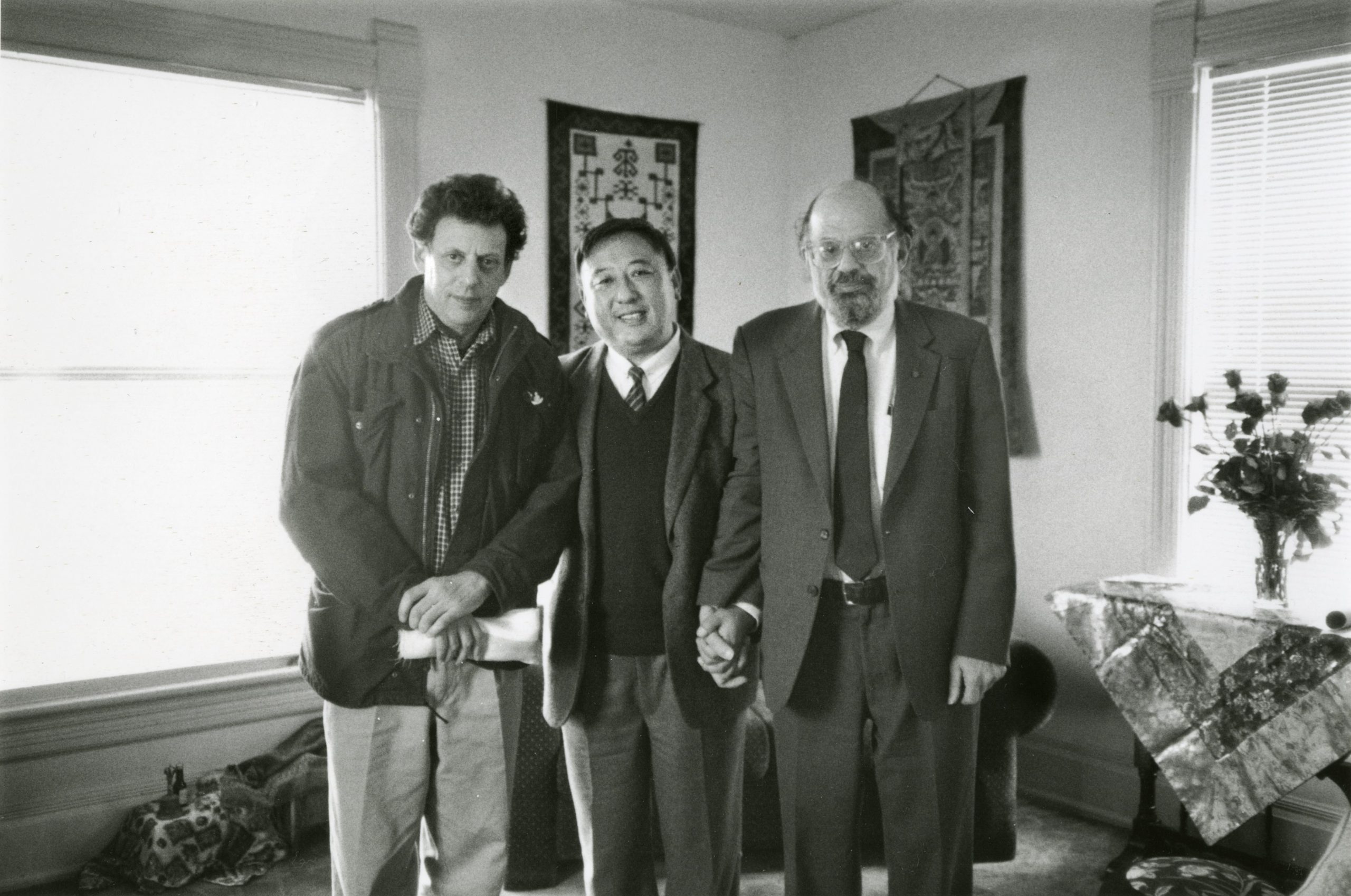
Philip Glass, Gelek Rimpoche, & Allen Ginsberg, Ann Arbor, Michigan November 18, 1989. Photo by Allen Ginsberg. Courtesy of The Allen Ginsberg Estate.
After Rimpoche passed away in 2017, I kept thinking of how the photographs I had seen of Rimpoche taken by Allen caught the essence of Rimpoche as a Tibetan master. They also reflected how Rimpoche, who had come from a much different world in the East, was able to attract, teach, and form close connections with Allen and many other extraordinary open-minded individuals in the West who were interested in transforming themselves and their society. The photos said a lot about Rimpoche, Tibetan Buddhism, Rimpoche, and Allen’s relationship, and the interest in dharma and spirituality in the West.
In the Summer of 2018, I had the opportunity to meet Peter Hale, the manager, archivist, and photo archivist, of The Allen Ginsberg Estate. Carole Corcoran, a Co-Executive Director of Jewel Heart (and a relative of mine) arranged and attended this meeting held at Allen’s former loft and home, now the Estate’s office. Carole and Jewel Heart were a huge support in all aspects of the exhibit. Peter and I agreed the time was right to develop and curate a show of Allen’s photos of Rimpoche in his memory. Allen’s 2,500 contact sheets housed at Stanford University with his photo archive had recently been digitized, making the photos more accessible. We also recognized there was again a growing interest in dharma and spirituality in certain circles, and saw the show as a way to present positive ideas at a time the county was increasingly polarized.
We began the process of identifying and narrowing down images for the show. Peter typed “Gelek Rimpoche” into the database and the search results showed 139 relevant contact sheets which Peter transferred to me on a portable drive. And in the summer of 2018, I studied these contact sheets, identifying possible images for the show. I found important images of Rimpoche with other great Tibetan masters, including Ribur Rimpoche and Khylogla Rato Rimpoche, images we had not known about. There were also many images of Rimpoche with monks, Tibetologists, friends, and students, including Philip Glass, artist Francesco Clemente, founder of Tibet House US, Robert Thurman, poet Anne Waldman, and songwriter, singer, and poet, Patti Smith.
Following my initial review, Peter and I further narrowed our selection to fifty negatives guided by Allen’s extensive notes on the contact sheets and images he’d circled with the intention to print. We would not know if we could include any of these images in the show until Stanford digitized the negatives so we could review them. Stanford generously scanned the negatives without charge, with the help of Stanford librarians, Tim Noakes and Glynn Edwards.
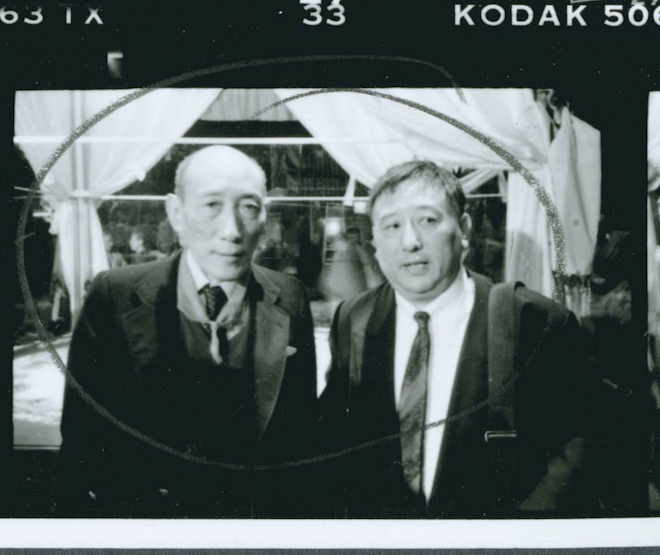
Contact Sheet showing Allen’s handwritten circle of his photo of Khyongla Rato Rinpoche& Gelek Rinpoche, New York City October 21, 1991. Courtesy of The Allen Ginsberg Estate.
In the spring of 2019, Peter and I reviewed the scanned negatives Stanford had sent to us, picking thirty-six negatives to include in the exhibit. Ready to print, the photographer Brian Graham, who printed for Allen and photographer Robert Frank when they were alive, put us in touch with John T. Hill, John, a graphic designer and photographer associated with Yale, best known as the executor of the Walker Evans estate, oversaw the process of printing the scanned negatives.
In September 2019, we were ready to pick the venue. Tibet House in New York City was our first choice based on the many interconnections between the organizations and individuals involved. Philip Glass, Chairman of Jewel Heart is Vice President of Tibet House. Robert Thurman met Rimpoche and Allen in the 1960s and remained close to both. Allen had played at most if not all of Tibet House’s annual concerts when he was alive. The choice was also special to me personally. Rimpoche was a Director of Tibet House Delhi in the 1960s and my late grandmother worked there in the 1980s.
In September 2019, we contacted Robert Thurman about the possibility of holding the exhibit at Tibet House. He was in Bhutan and responded enthusiastically, suggesting we contact his wife Nena Thurman, also an old friend of both Rimpoche and Allen. She put us in touch with the Tibet House team, led by Beata Tikos, Managing Director, and Kyra Borre, Director of Programs and Special Events. Both provided us enormous support in all aspects of Tibet House presenting the exhibition. On January 28, 2020, we met with Tibet House and discussed the details of holding the exhibit there. I was in Baltimore at graduate school unable to attend. Peter showed several prints we planned to include in the exhibit and discussed the premise of the show. These photos celebrated Gelek Rimpoche and the unique relationship between Allen and Rimpoche and others interested in transforming themselves and society, ideas which were important then and relevant in current times.
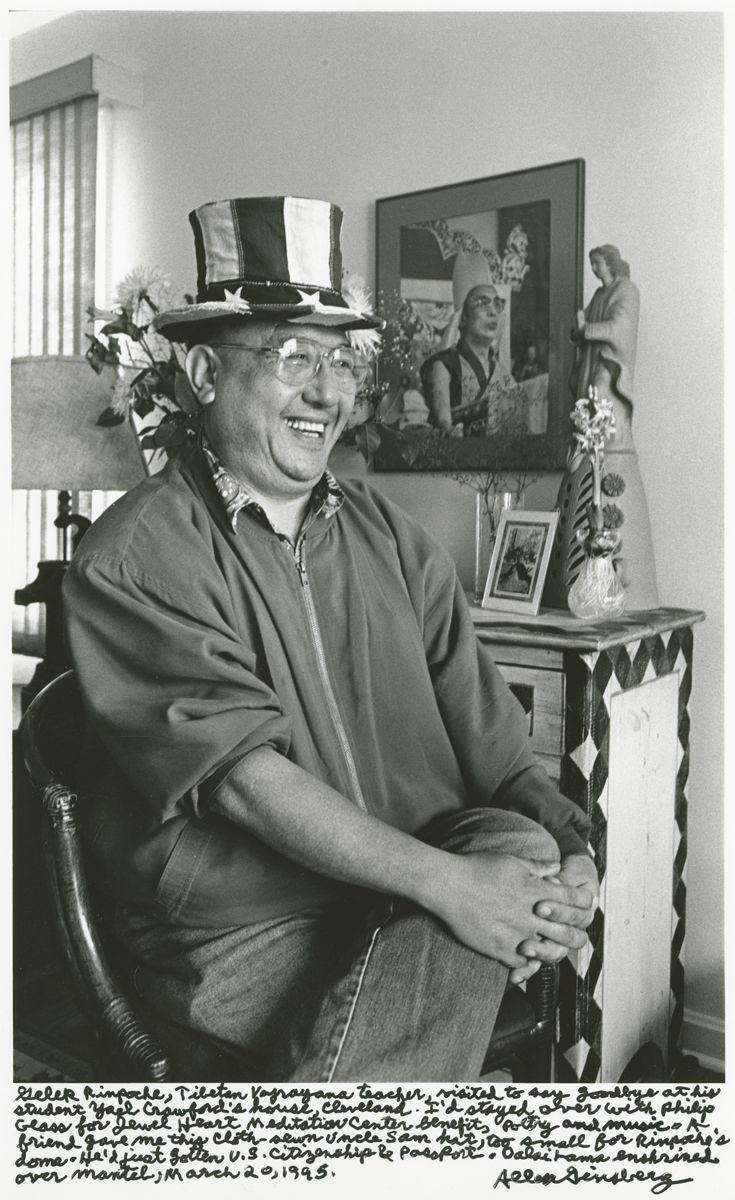
Gelek Rimpoche, Cleveland, Ohio March 20, 1995. Photo by Allen Ginsberg. Courtesy of The Allen Ginsberg Estate.
Tibet House agreed to host the exhibition in partnership with Jewel Heart and The Allen Ginsberg Estate. We planned to hold the exhibit in the Summer of 2020 showing thirty-five to forty-five photographs with Peter and I co-curating the show. The meeting ended with everyone expecting to make quick progress on the show. However, two weeks later, the Tibet House and much of the US and world shut down due to the Covid-19 pandemic, causing the show to put on hold. We checked in periodically over the next year, and in the Spring of 2021, Tibet House suggested and we agreed that the exhibit be held September 21, 2021, through December 12, 2021. (The show was later extended through February 14, 2022.) The opening would be Tibet House’s first in-person event since the pandemic had forced their closure.
We started to move forward finalizing the show. Carole, Philip Glass, and Nancy Jeffries, Co-Executive Director of Jewel Heart, focused on finding an appropriate title for the exhibition. In the end, the title came from Rimpoche’s own description of what he, Allen and other friends were doing in the early 1990s – learning about transforming minds. We proposed the same as title and it was quickly approved by all stakeholders: Transforming Minds: Kyabje Gelek Rimpoche and Friends, Photographs by Allen Ginsberg 1989-1997.
We focused on framing the prints. We considered several options including the dark grey frames with white matting favored by Allen in the 1990s, black frames, and light wood frames with or without matting. Unsure, we asked Alba Clemente, who was close to both Rimpoche and Allen and has impeccable taste. She suggested brushed grey frames. After talking with Tibet House, we chose an elegant light silver frame and white matting, which I thought went well with framing photographs of Rimpoche and other Tibetan masters. John T. Hill arranged for the framer in New Haven, Jon Scholfield, to frame the prints professionally and at a reasonable cost.
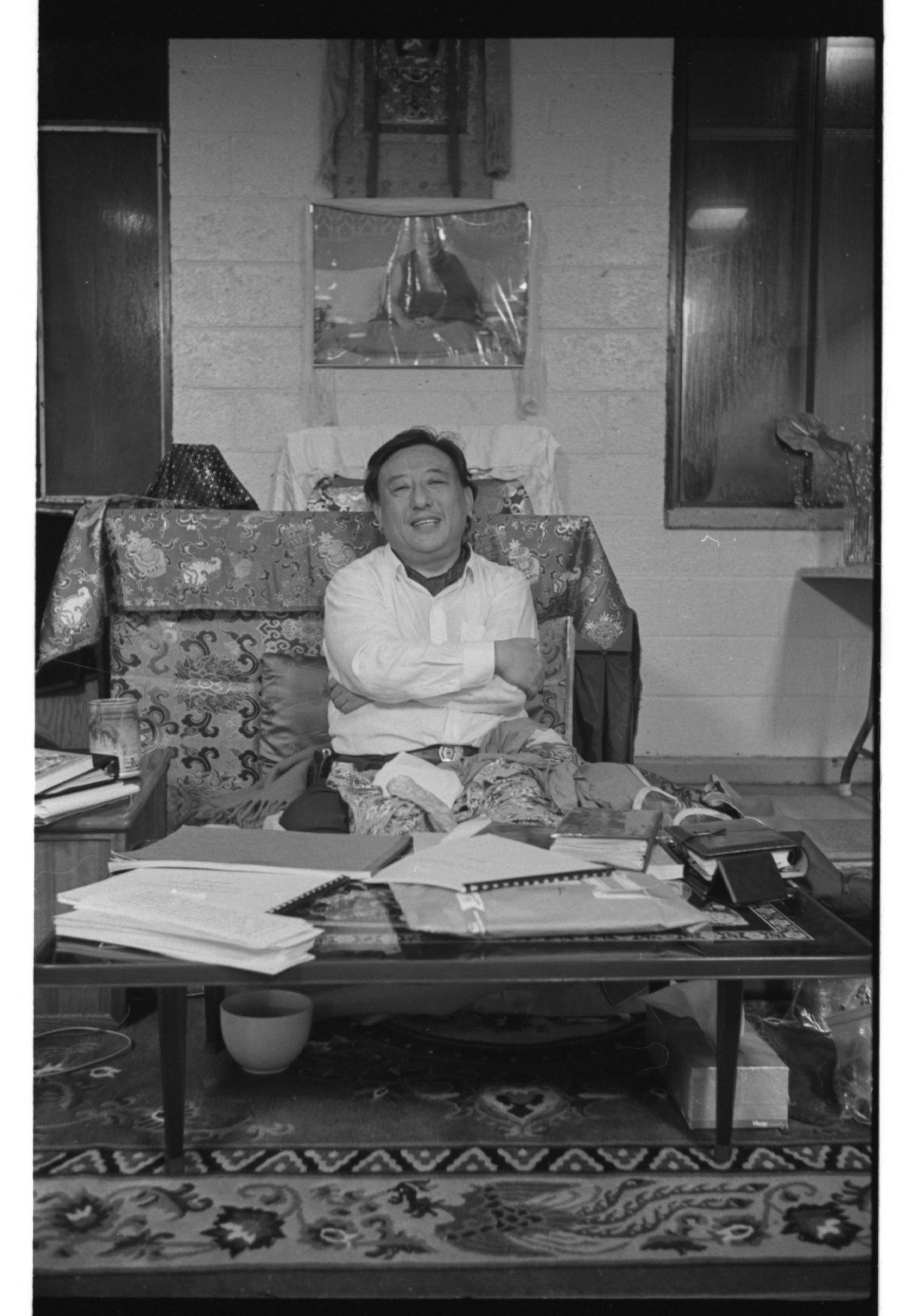
Jewel Heart Winter Retreat, Proud Lake Recreation Center, Commerce Township, Michigan. December 29, 1992. Photo by Allen Ginsberg. Courtesy of The Allen Ginsberg Estate.
Peter and I then laid out the curation of the show. We decided to include forty prints, thirty-four from the digitized scans from Stanford, and six which had been printed previously and inscribed with Allen’s handwritten captions. We planned to hang the show chronologically and to use quotes and text from Allen, Rimpoche, and others to give some context to the show. For viewers who wanted to know more, we planned to play a loop of a film in the gallery’s main hall showing excerpts of Rimpoche and some of his friends in the photographs performing and interacting. Carole and Jonas Berzenkis of Jewel Heart put together this thirty-four-minute film. Highlights of this film include excerpts of Allen reading his spiritual biography at a Jewel Heart Summer Retreat, Allen singing his poem “Do the Meditation Rock” at a Jewel Heart benefit, and Rimpoche debating with Robert Thurman on artificial intelligence at a Jewel Heart benefit.
In July and August 2021, Peter and I worked closely with the Tibet House on the administrative aspects of opening the show. Peter prepared the labels and related captions for all the photos, and together we prepared the curators’ statement, the curatorial statement, and all the texts and quotes we wanted to use (with poet Simon Pettet assisting in editing). Tibet House handled printing and proofing of this text, designed a special website and registration pages with web designer Joe Cosey, prepared the gallery for installation, established Covid-19 procedures, and arranged all staffing details for the exhibition.
Peter and I also worked closely with Tibet House and Jewel Heart on the marketing aspects of the show. Tibet House prepared the press release and hired videographer Thomas Tikos- Kadji who made two strong promotional videos for the show, one for Instagram and a longer one for websites. With Jewel Heart’s support, we hired Carl Tsigdinas, a designer in Ireland, who created four promotional posters for social media, and one poster to be printed and sold, using photos of Rimpoche from the show. I felt strongly that the printed poster should be one of Allen’s photos of Rimpoche teaching. We chose a 1997 photo Allen had taken of Rimpoche teaching at Jewel Heart’s winter retreat, one of the more interesting photos in the show, and one taken shortly before Allen died. Tibet House, Jewel Heart, the Estate, Philip Glass, Peter and I, and many individuals involved, promoted the show through emails, social media, or otherwise.
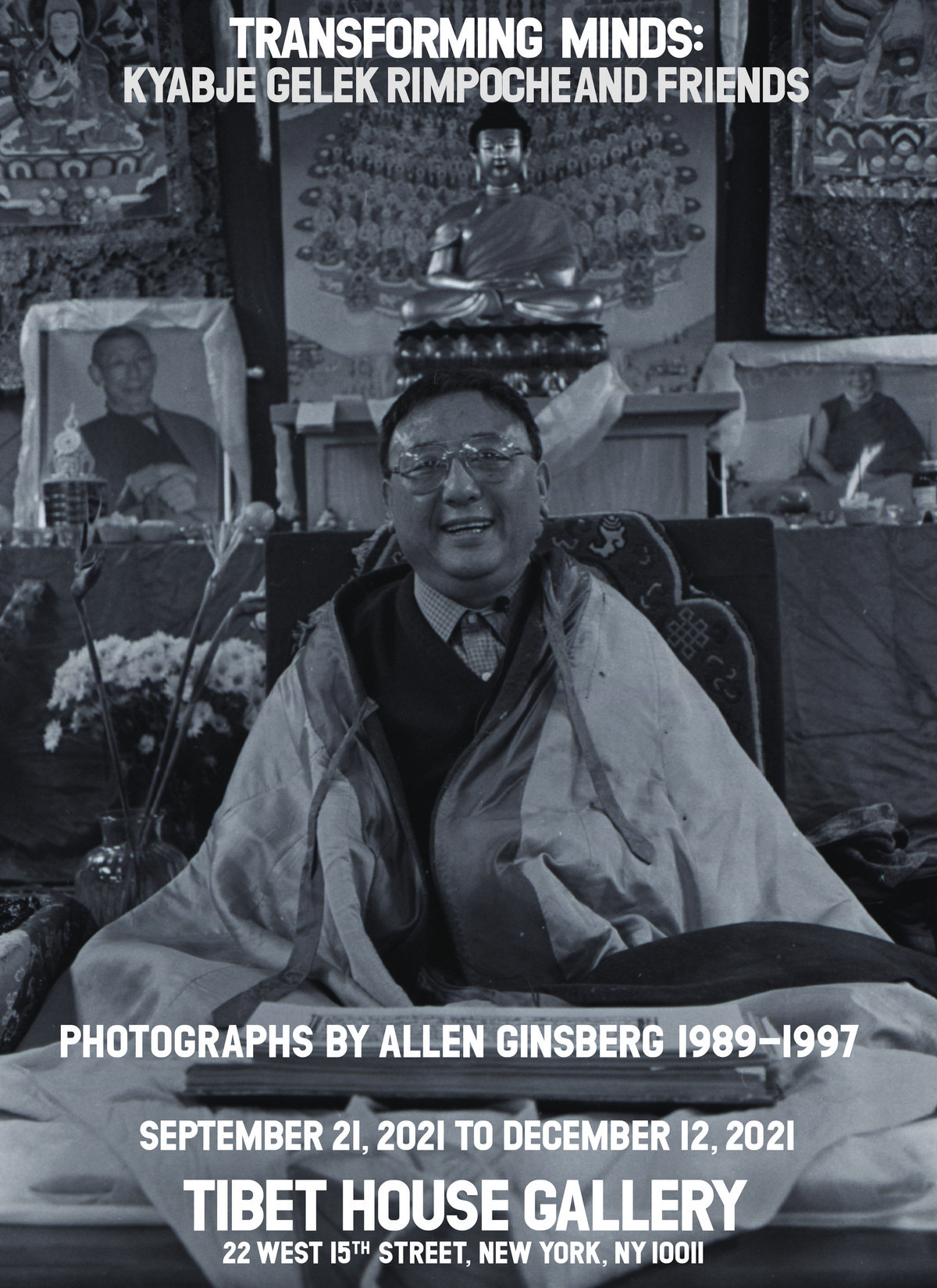
Printed Poster for Show. Jewel Heart Winter Retreat, Camp Copneconic, Flint, Michigan January 1, 1997. Photo by Allen Ginsberg. Courtesy of The Allen Ginsberg Estate.
On September 10, 2021, Peter and I drove to New Haven, met John Hill, reviewed and picked up the framed photographs, and delivered them to Tibet House. On September 13th, we met the Tibet House team at Tibet House to install the show. Everyone was masked and in a festive mood. We all looked together for the first time at the framed photos and at the show’s wall text which Tibet House had beautifully printed on a grey background with white letters to match the silver frames.
James Lecce did a wonderful job preparing the gallery, and later, in hanging the show. In looking at the gallery, hallway, and photos, we slightly adjusted our plan to hang the photographs chronologically. Out of respect, we decided to hang the photographs of His Holiness the XIV Dalai Lama, and other Tibetan masters together on one wall out, separate from other photos. For the same reason, we hung the photos of Rimpoche teaching separate from photos of him engaging in everyday activities. We also decided to group certain related photos together. Otherwise, we followed our curation plan.
The show opened on September 18, 2021, though there was no formal opening due to Covid. The exhibit was powerful, emotional, and intimate. The photos stood out as art while documenting Rimpoche as a Tibetan master, teacher, friend, and human being interacting and connecting with Allen, friends, and others. Allen captured Rimpoche’s strength, dignity, kindness, compassion, joy, and sense of always being relaxed in his own body. Each time I visited the show, there was a serious almost reverential silence in the gallery as viewers moved around looking at the photos, talking quietly, reading the text, and sitting and watching the film.
Hearing from many people who were unable to come in person due to Covid-19, we worked with Tibet House and Jewel Heart to create a virtual show which became available in early October 2021. We hired a videographer, designer, and founder of the Yakpo Collective, Tsewang Lhamo, a friend since college, to create the virtual show after I saw and liked the virtual show Transcending Boundaries” she helped create in 2021 using kunstmatrix software. I worked with her to produce the virtual version of our exhibit in a way that mirrored the Tibet House show.
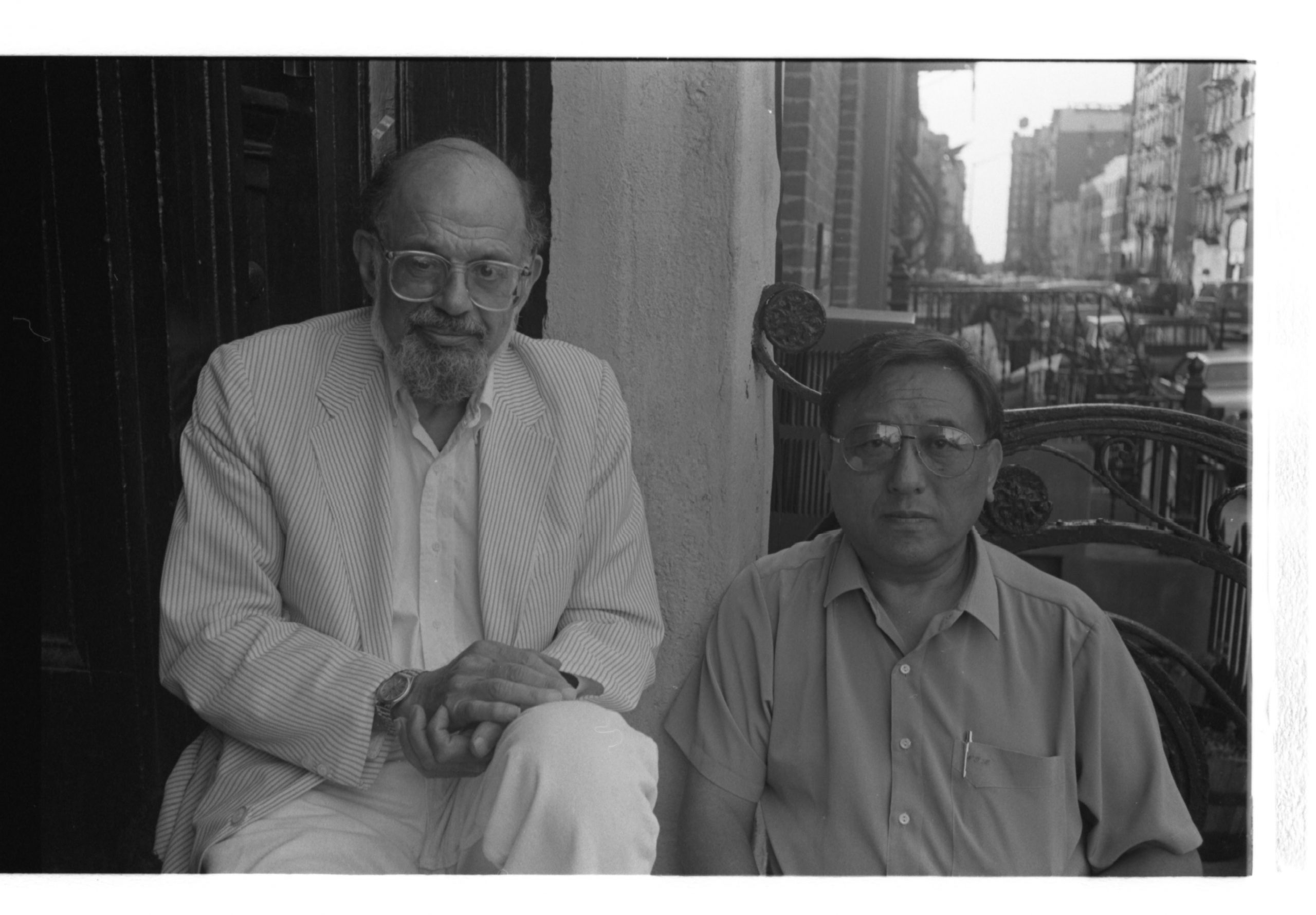
Allen Ginsberg & Gelek Rimpoche, Lunch Break on Philip Glasses Stoop, New York City September 12, 1992. Photo by Allen Ginsberg. Courtesy of The Allen Ginsberg Estate.
It was an honor to work with Peter in developing and co-curating this show. I think we balanced each other with our perspectives, experiences, and vision. Peter in one way was Allen’s representative and I was Rimpoche’s representative. Peter is an American intellectual and I am a Tibetan multidisciplinary artist who was born in Tibet, came to the US at fifteen, and grew up in a Tibetan spiritual environment. We both had the goal to present the show as professionally as possible.
The show can be viewed from different perspectives, including celebrating Allen’s photography as art and celebrating Rimpoche and Allen’s unique relationship. Agreeing with these perspectives, and there are others also, I see the show more broadly as celebrating Gelek Rimpoche as a Tibetan lama, working with Allen and others, using Tibetan Buddhist ideas to teach them how to transform themselves and society, ideas which were important then and remain relevant and needed in current times. This is the reason I was involved with the show and believe it is important.
I would like to thank everyone who helped us develop, curate, and put on this show. As I noted in the beginning, this show was a collaborative effort and would not have happened without the help of all the people and institutions mentioned in this paper, and others. I again extend gratitude to Tibet House and its team, Jewel Heart and its team, particularly Carole, and The Allen Ginsberg Estate and Peter.
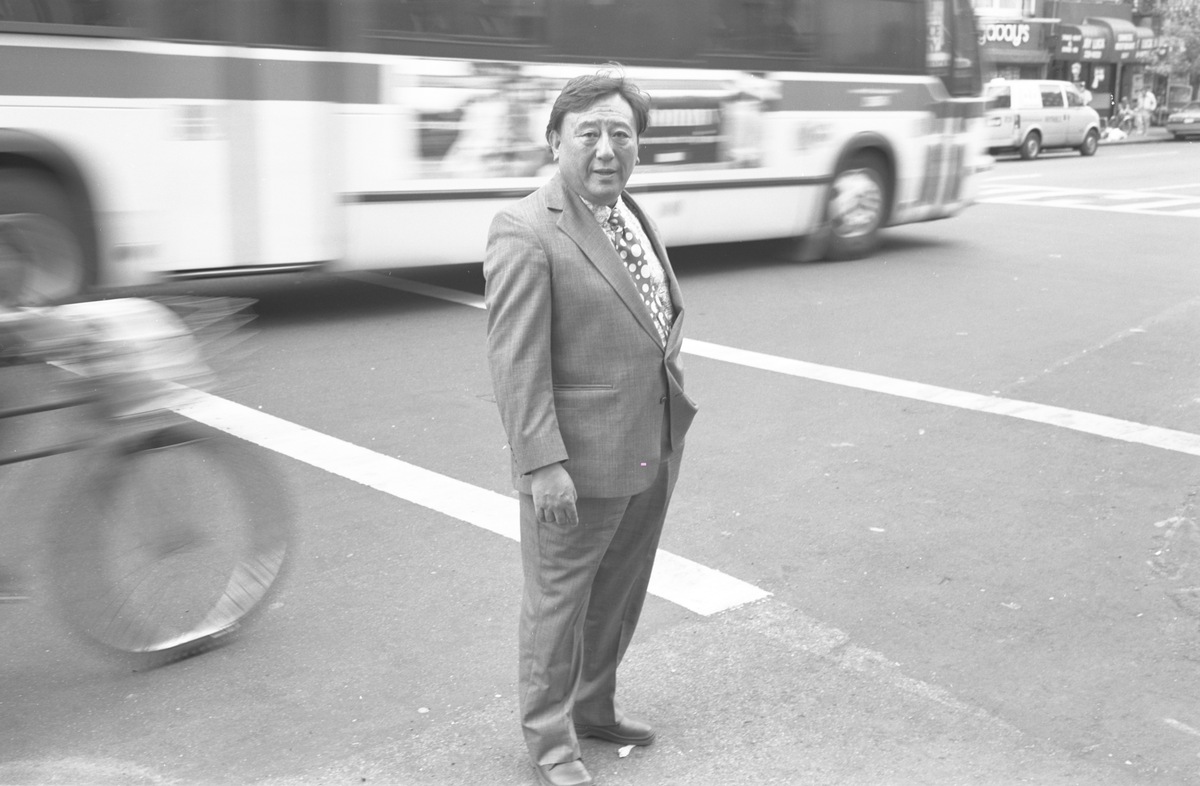
First Avenue and Thirteenth Street, New York City September 25, 1995. Photo by Allen Ginsberg. Courtesy of The Allen Ginsberg Estate.
Ben Paljor Chatag is a Tibetan American contemporary multi-disciplinary artist. He was born in Lhasa, Tibet, lived in Northern India as a refugee, and now calls the United States his home. His practice explores current social, cultural, and political issues using Tibetan philosophy to illuminate contemporary challenges. Ben has an M.F.A. from Maryland Institute College of Art, Mount Royal School of Art (2020). He has also studied traditional Tibetan Thangka painting in Northern India. His work has been shown in solo and group shows in New York and Maryland. He most recently was co-curator of an exhibition of Allen Ginsberg photos of the Tibetan master Gelek Rimpoche at Tibet House USA Gallery and completed the Home & Away Oolite Arts Anderson Ranch Residency in March. Ben lives and works in Miami.
© 2021 Yeshe | A Journal of Tibetan Literature, Arts and Humanities